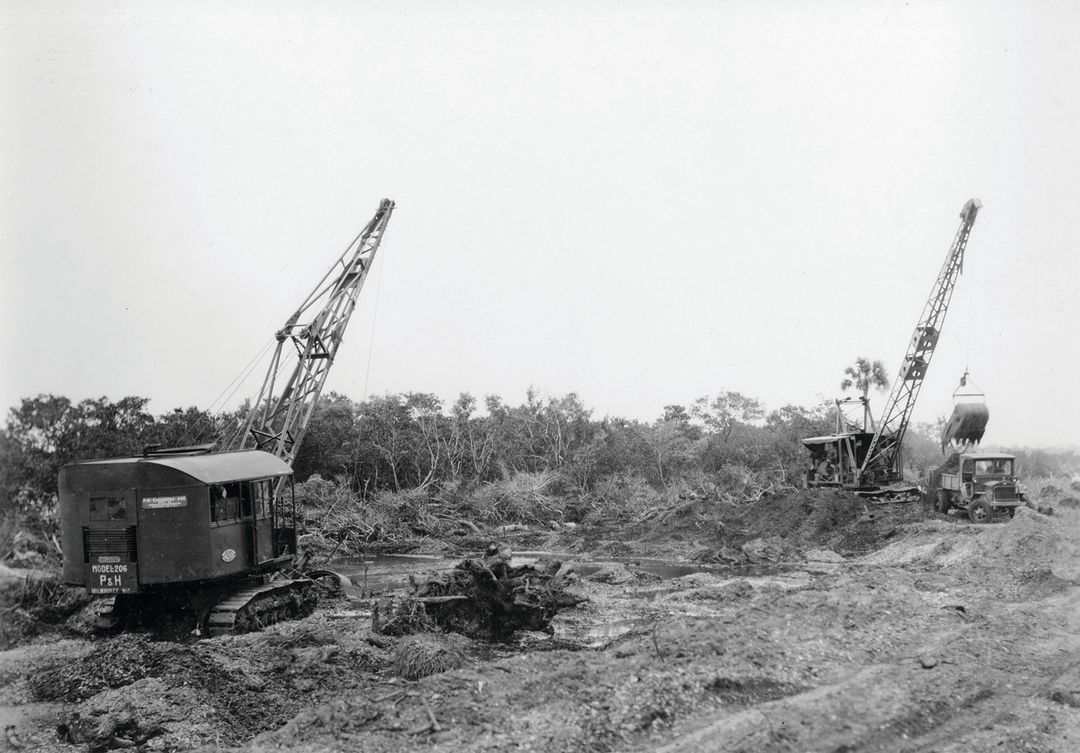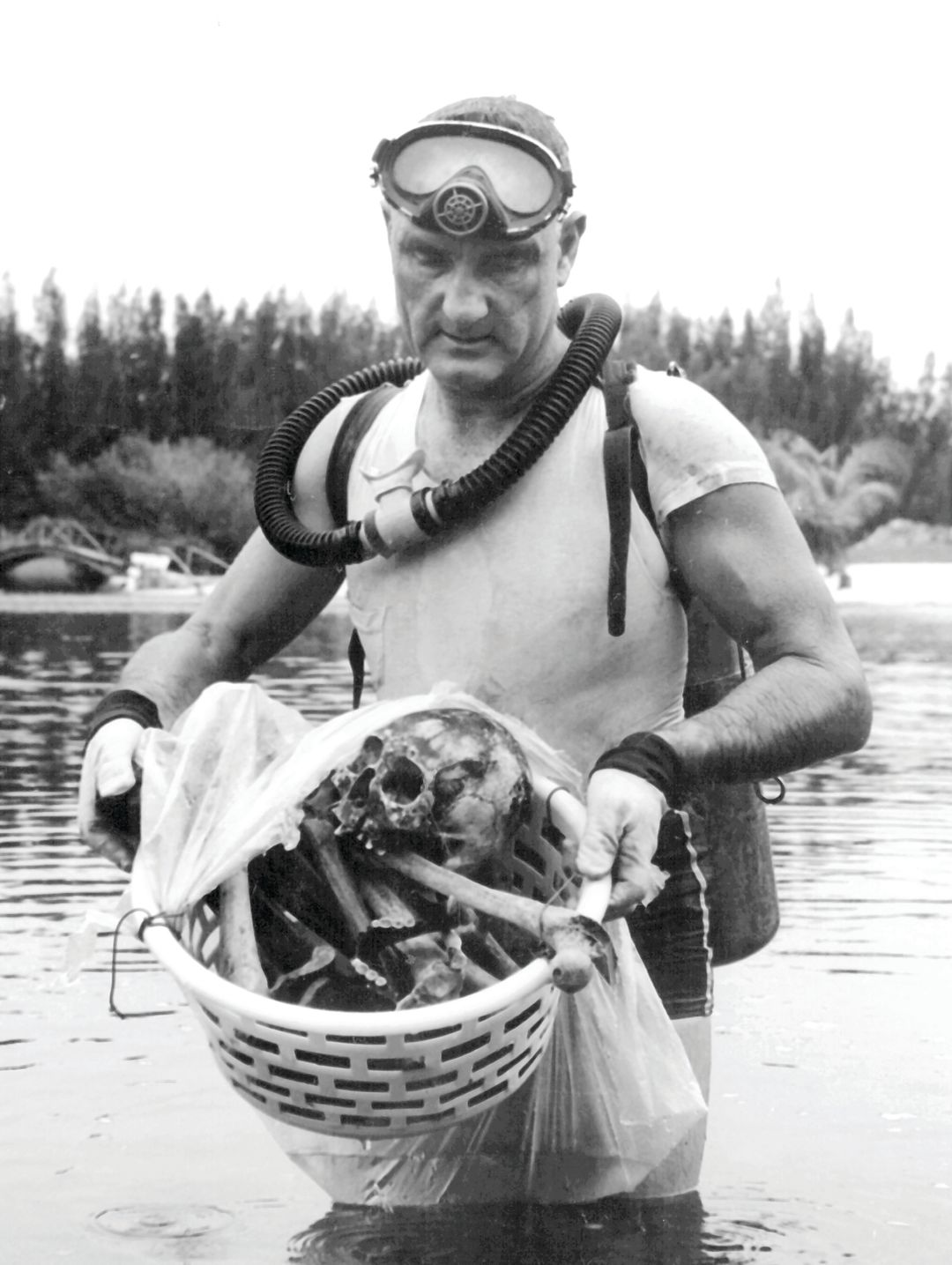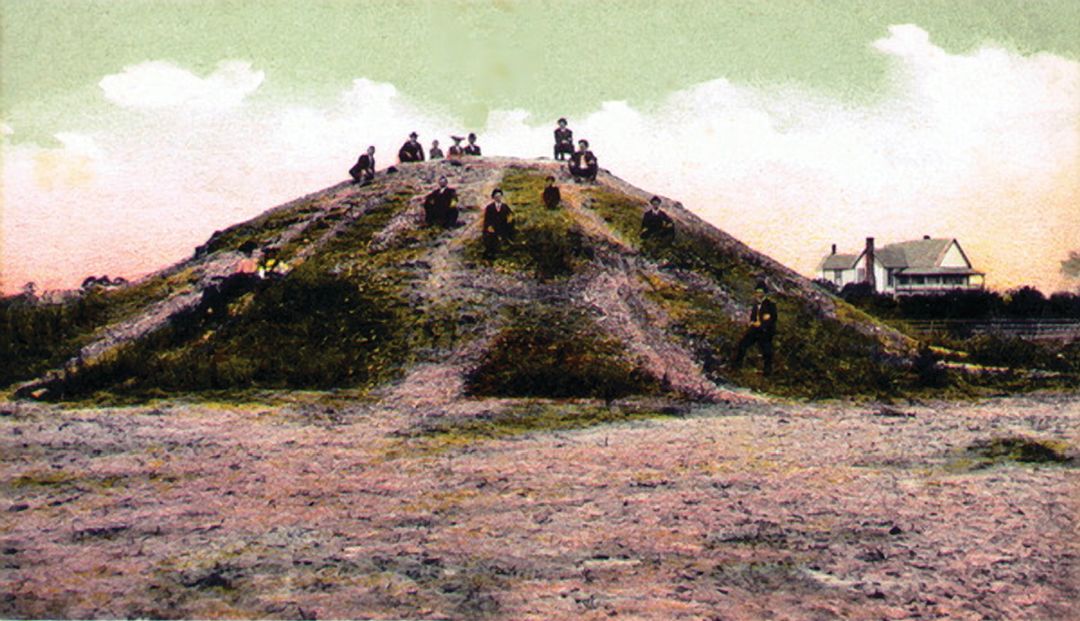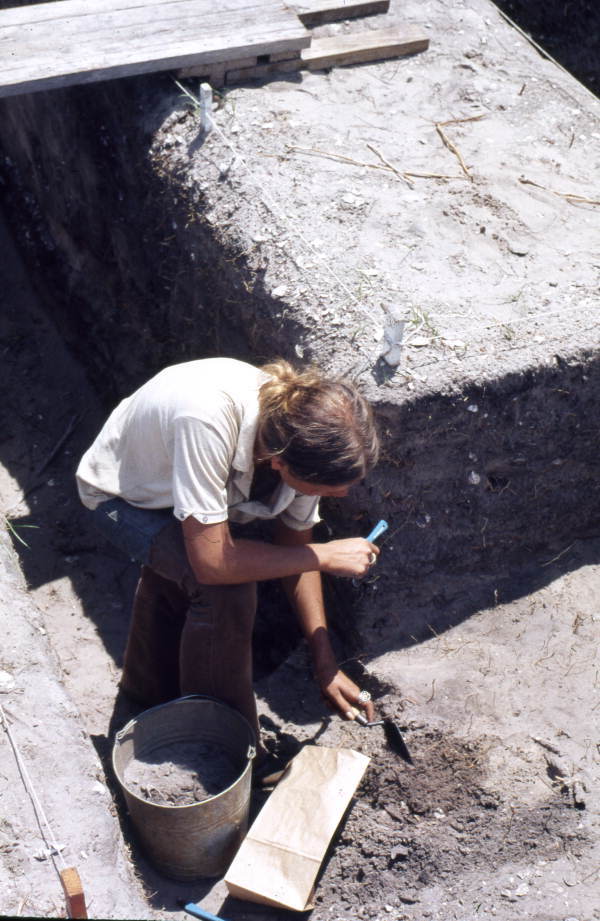
Remnants of Ancient Civilizations Are Still Around Us, But They’re Vanishing Fast
Colonel William R. “Bill” Royal (1905-1997) started diving into North Port’s Warm Mineral Springs and Little Salt Spring in 1959, after he retired from the Army. “Skin diving” was considered adventurous and dangerous in those days. A television show featuring divers, Sea Hunt, had become popular just one year before. But Royal took things much farther than the show’s star, Lloyd Bridges, ever did. Warm Mineral Springs was murky and mysterious, 220 feet deep, and no one had ever been down there.
Royal and his diving partner, Dr. Eugenie Clark, a marine biologist who became the founder of Sarasota’s Mote Marine Laboratory, were surprised to find human bones embedded in the spring’s muddy walls, about 35 feet below the surface. Underwater archaeology was rare in those days, and people didn’t know what to make of the bones. Reporters were called in, and on July 11, 1959, a camera crew from NBC’s Huntley-Brinkley Report recorded Royal discovering something unprecedented—a human skull that contained a well-preserved brain. The timing of the crew’s visit was unfortunate, because the on-camera discovery seemed so outlandish that archaeologists figured it must be a hoax.
It wasn’t. The springs’ mineral-rich water had kept the brain from rotting, and the skeleton was carbon-dated to an age of more than 7,000 years. Other bones from the spring were dated at 10,000 to 11,500 years, which made them the earliest human remains yet discovered in North America. Bill Royal had made a major discovery.

Bulldozers plow through an archaeological site in Venice in 1926.
Image: State Archives of Florida
The problem was, he wouldn’t stop. Royal pulled pieces of seven or eight skeletons out of the springs, along with the remains of giant sloths, mastodons and lots of other things. The springs were a privately owned tourist attraction, and some of the bones were left out for tourists to examine, which mixed them up beyond traceability. Others were built into the fireplace at Royal’s home as trophies.
Archaeologists are still peeved at Bill Royal for removing artifacts from their primary context without charting their position or analyzing the strata around them. Royal protested that he couldn’t get people to take his claims seriously until he showed them the goods. But according to Steve Koski, Sarasota County’s staff archaeologist, who met Royal when he was still an active diver well after his 80th birthday, “Bill loved diving, and all he wanted to do was dive. It drove him crazy when the state’s underwater archaeologist, Sonny Cockrell, told him he couldn’t go in.”
And Royal was just one individual. Our civilization has dug up a lot of land since human settlement began in Florida 12,000 years ago. We uncovered a huge number of fossils, prehistoric artifacts and human remains, and we threw most of those discoveries away. We’ll never know how much we could have learned, but “the loss was massive,” says Koski.
There are 319 officially recognized archaeological sites in Sarasota County, and 66 of them are likely to contain human remains. And even those officially recognized sites are just a fraction of all the sites in the county.
We know very little about the first human community to settle here for several reasons. First, the previous tenants didn’t leave anything in writing. They left bones, lightly decorated pottery fragments, a lot of kitchen garbage and tools made of stone, shell, bone and shark teeth. (Yes, they picked up stuff at the beach and made things from it, just like we do.) They also didn’t talk to journalists. The Europeans who first encountered Florida natives in the 16th century tried to enslave and kill them. Europeans also brought plagues that devastated the tribes. When another group of explorers came to Florida in the 18th century, the villages were largely abandoned. The only descriptions we have of native Florida civilizations come from diary entries and letters written by distant observers.
Today there are serious legal penalties for disturbing human remains, no matter how old they are, and people are supposed to get a state permit before they dig up fossils. In public, archaeological sites are spoken of as cultural resources that need be protected, and (one hopes) most people believe it’s unacceptable to dig up people’s bones. But remember, we’re talking about fast-growing, frontier-minded Florida. Local archaeological sites are still being destroyed by looters, collectors and contractors. Some are even being destroyed legally. Just last year, the remnants of a large, historically important shell mound were hauled off Venice Beach by a condominium developer.

Diver Bill Royal scooped out human skeletons from Warm Mineral Springs in 1959.
Image: Courtesy Photo
The Lost Village
Much of the evidence we have of native Floridians comes from the materials they buried in large piles of shells known as mounds or middens. For most of the 20th century, these piles were mined and hauled away.
My great-uncle, Frank Beyer, was part of that. He operated road graders and steamrollers in Southwest Florida in the 1920s. After a dump truck spread mound material onto a roadbed, Frank would follow and smooth out the material before rolling it flat. When the grader turned up a big bone or pottery fragment, he’d retrieve it and throw it into a box. When the box was full, he’d send it to the State Museum.
Frank was smart. He knew he was disturbing human remains, and as an old man, he told the story with regret. But it happened during the Great Depression, he said, and this was his job. It was the best he could do.
One of the biggest mounds in this area was located on Venice Beach, centered around the intersection of Tarpon Center Drive and The Esplanade. It’s known as the Higel Mound because one of Venice’s founders built his house on it in 1883. Clyde Higel (1908-1982) described the mound: “At the highest point it was 30 feet high and at least 250 feet across...The midden ran across the beach and curved where it turned into the bay behind an old bayou . . . [We found] burials when our house was built, where [the condominium] is today. I ran into half a dozen or so burials when I dug the footings for the houses that used to be on the beach.” A freshwater spring flowed on the mainland side of the highest point of the mound, which was just south of Ormond Street.
Draglines first cut into the Higel Mound in the 1920s to pave Venice’s streets, and they came back in 1951 to dredge the harbor for the Venice Yacht Club. This wasn’t controversial. Florida’s transportation department carted away hundreds of mounds all over the state, and they didn’t stop until the mid-1950s.
The mounds were typically located near the Gulf or on major rivers, which were primary sources of food for the natives who lived there. They were usually part of larger settlements, and this seems to have been true in Venice. Several large archaeological sites have been identified within a few miles of the Higel Mound, including a burial mound near the mouth of Shakett Creek that was obliterated in the 1930s. Mounds were used as homesites, and as refuges during storms. They were rebuilt and added to over centuries. Some were used as platforms for religious ceremonies and some were used for burials, although many do not contain human remains.
Koski began studying Venice Beach as a graduate student in 1985. He has used radiocarbon analysis to date a stone arrowhead found near the spring to the Paleoindian period, which began more than 10,000 years ago. Other artifacts provide evidence that the site may also have been occupied when the Conquistadors arrived about 500 years ago.
A description by a member of the Hernando De Soto expedition hints at what the settlement on Venice Beach might have looked like. De Soto and his troops briefly occupied a native settlement on the southern shore of Tampa Bay, about 40 miles from Venice Beach by canoe, in 1539. The abandoned village of Ucita was “seven or eight houses, built of timber and covered with palm leaves,” wrote the soldier. “The chief’s house stood near the beach, upon a very high mound made by hand for defense; at the other end of the town was a temple, on the top of which perched a wooden fowl with gilded eyes.” He says that De Soto burned Ucita and the surrounding fields of pumpkins, beans and other crops as soon as he finished ransacking—except for the chief’s house, which DeSoto used as his temporary headquarters.
“We don’t know what the Higel Mound was used for,” says Koski. “But if it had survived, I think it would have qualified as a National Historic Landmark.” Before the last remnants of the mound were removed in 2017, the developer made a cursory examination after a request from a neighbor. He wasn’t required to do that, because the City of Venice does not have an ordinance that protects archaeological sites.

Some shell middens, like this one in Southwest Florida circa early 1900s, dominated the landscape.
Image: State Archives of Florida
A 3-D Jigsaw Puzzle
OK, so the Higel Mound was never examined by archaeologists. Why should we get upset about losing a few dump truck loads of shells, even if they were piled up by natives? We have thousands of artifacts. Why do we need more?
One answer is that archaeological sites are historic places and are just as important as a community’s first homes or churches. Another is that the sites are not mines, but pieces of a puzzle that is still being assembled. Evolving tools like sonar, ground-penetrating radar and computer visualizations make it fruitful to return to sites as techniques evolve and other discoveries are made. Analyzing the soil around an artifact, known in the field as its “primary context,” yields important facts about that artifact. And it’s impossible to learn anything from a site that has been destroyed.
It galls archaeologists when people, like Royal, remove artifacts without charting and analyzing their location. If you bring a discovery to someone’s office, you’re likely to get a lot of questions before you get answers. And if you can’t lead them to the spot where you found the thing, they won’t be happy. Archaeology is slow and painstaking, with as much time spent in the lab as in the field. Analyzing a site is like assembling a three-dimensional jigsaw puzzle that has some pieces missing.

A researcher sifts through a shell midden in the Tampa Bay area.
Image: Courtesy Photo
It's Complicated
The relationship between professional archaeologists and amateur collectors is complicated. Sonny Cockrell once said that treasure hunting is “worse than the slaughter of whales or the pollution of the environment. If you stop killing whales, the species will come back, but you can never replace an archaeological site.” Still, if it hadn’t been for Bill Royal, Cockrell might not have learned about Warm Mineral Springs.
Royal also liked to dive for shark teeth off Venice Beach. (Archaeologists don’t mind that at all, because a shark tooth sloshing around on the floor of the Gulf or in a riverbed has already been removed from its context). One day he found deposits from the prehistoric village located just offshore. Royal invited Reynold Ruppé, an archaeologist from Arizona State University who was working with Cockrell, to see them. Ruppé and several of his graduate students mapped the underwater site, which turned out to be quite large. One of his graduate students was Steve Koski.
That was more than three decades ago. Today, as county archaeologist, Koski doesn’t have much time to pursue research. He talks to collectors, visits sites and attends meetings. He is a mediator between competing factions: collectors who want trophies, Native Americans who want to leave burial sites undisturbed, developers for whom time is money and artifacts are obstacles, and ordinary people who have found something and want to know what it is.
Koski is backed up by Chapter 66, Article 3 of the Sarasota County Code, which prohibits disturbing sites of historic or archaeological significance without approval from a review board. But the county ordinance only applies to nonincorporated land. The City of Sarasota has a similar law, and a history of enforcing it; North Port’s law has not been enforced.
That leaves Venice, which has a historic preservation ordinance that applies to six properties on the National Register of Historic Places, none of them archaeological sites. Federal and state laws make it illegal to disturb human remains in the City of Venice, but any other artifacts located on private property are fair game.
Koski isn’t happy about the lack of protection in Venice, but he prefers to encourage rather than criticize. He’s a teacher. His advice to the public is simple: If you see a bone and you think it might be human, call the police. And if you see something else lying on the ground, call an archaeologist. “Just don’t pick up a shovel,” he says.
Archaeologists have learned a tremendous amount about native Florida over the last 30 years, and there’s a lot more out there to discover. Beginning in the late 1970s, Rey Ruppé used the underwater deposits at Venice Beach as evidence for a hypothesis. He argued that many other sites were also submerged just off the coast. Massive ice sheets locked up vast quantities of seawater during the Wisconsin glaciation 14,000 to 18,000 years ago, and Florida was about twice as wide then as it is now. Venice might have been on a river, but it wasn’t near the beach. When the oceans began rising about 11,000 years ago, said Ruppé, they slowly submerged places Paleoindians had lived and hunted.
Ruppé’s hypothesis was proven in 2017, when a burial site was discovered in a former marsh that is now under 22 feet of water off Manasota Beach. Ruppé, who died in 1993, “would have been thrilled” by the discovery, says Koski. “He would have seen it as a vindication.” He would also have been content to wait. A single lifetime is nothing to an archaeologist.
Go Native
How to learn more about early tribes and history.
The best guide to Florida’s native tribes is Jerald T. Milanich, formerly the curator of archaeology at the Florida Museum of Natural History in Gainesville. His 1994 book, Archaeology of Precolumbian Florida, is the standard text. Florida Indians from Ancient Times to the Present (1996) is an overview written for a wide audience, and Florida Indians and the Invasion from Europe (1998) focuses on their first contacts with Europeans and the catastrophes that followed. All are published by the University Press of Florida.
The best way for civilians to keep up with more recent discoveries is to get involved with the Florida Public Archaeology Network, which was organized by professional archaeologists in 2004 to improve outreach. Their active West Central division, which includes the counties surrounding Tampa Bay and extends southward to Sarasota County, offers opportunities for volunteering, public programs and more.
Brad Edmondson is a writer in Ithaca, New York. He was born in Venice, graduated from Pine View School in 1976, and went on to be editor-in-chief of American Demographics magazine. He is a regular contributor to Sarasota Magazine.